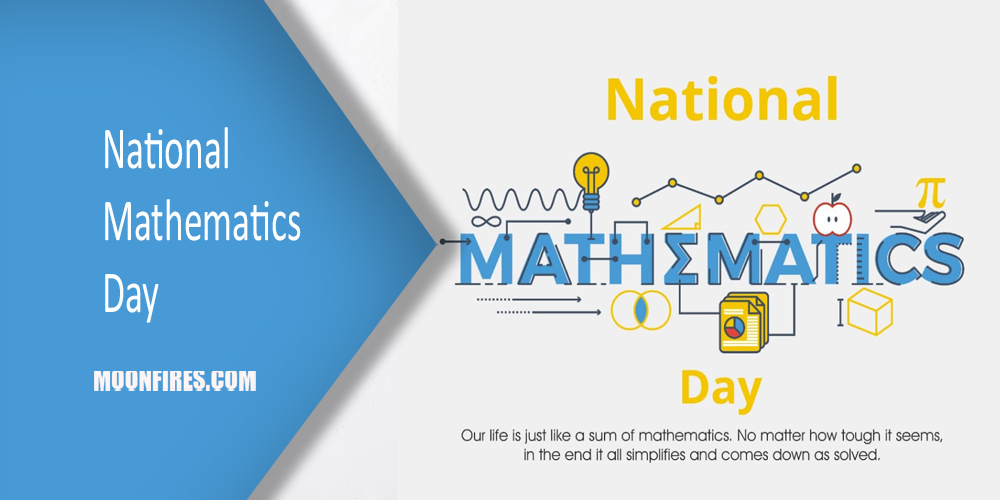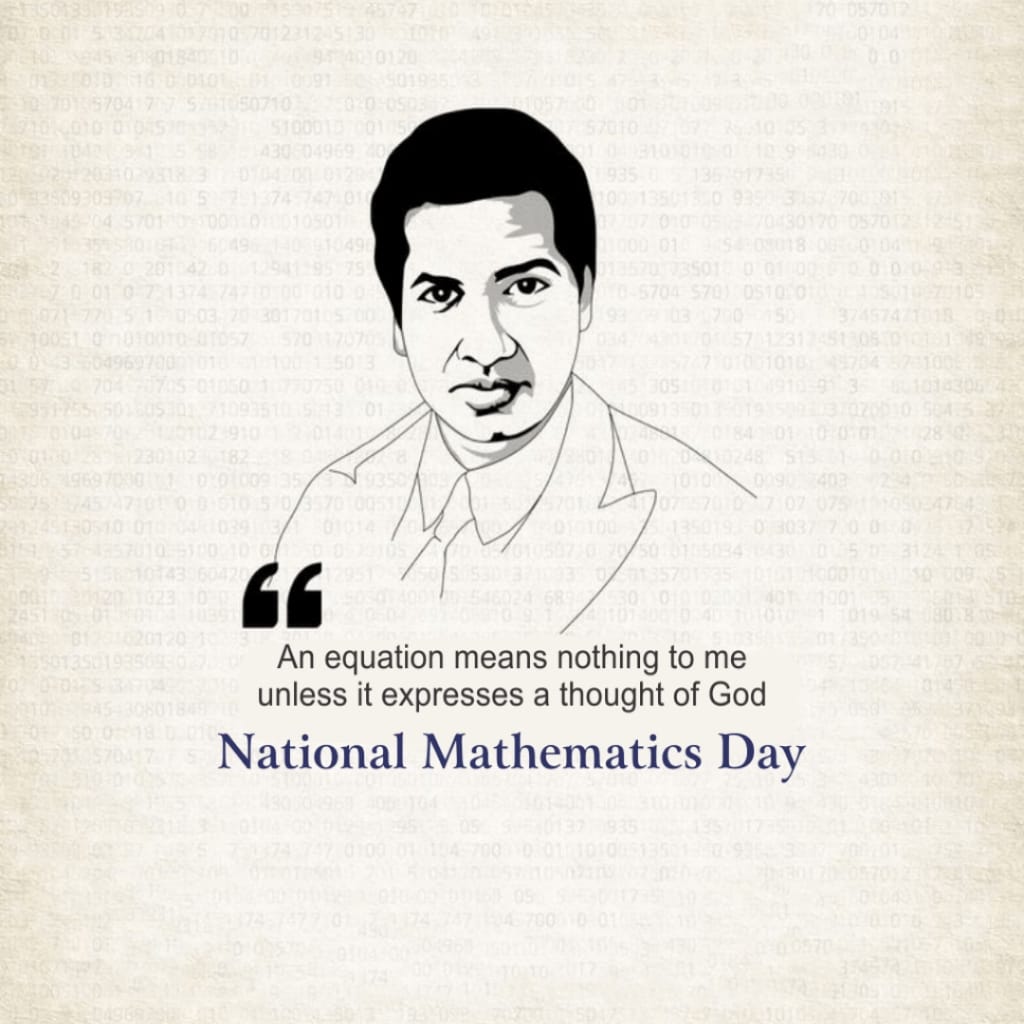
National Mathematics Day is celebrated on December 22nd every year to commemorate the birth anniversary of the legendary mathematician, Srinivasa Ramanujan. The day is dedicated to recognizing the significant contributions of Ramanujan to the field of mathematics and promoting the importance of mathematics in scientific and technological advancements.
Srinivasa Ramanujan
Born on December 22, 1887, in Erode, Tamil Nadu, Srinivasa Ramanujan was a self-taught mathematical genius who made substantial contributions to mathematical analysis, number theory, infinite series, and continued fractions. Despite facing numerous challenges, including a lack of formal education in advanced mathematics, Ramanujan's work has had a profound impact on various branches of mathematics.

When he was nearly five years old, Ramanujan entered the primary school in Kumbakonam although he would attend several different primary schools before entering the Town High School in Kumbakonam in January 1898. At the Town High School, Ramanujan was to do well in all his school subjects and showed himself an able all round scholar. In 1900 he began to work on his own on mathematics summing geometric and arithmetic series.
Ramanujan was shown how to solve cubic equations in 1902 and he went on to find his own method to solve the quartic. The following year, not knowing that the quintic could not be solved by radicals, he tried (and of course failed) to solve the quintic.
It was in the Town High School that Ramanujan came across a mathematics book by G S Carr called Synopsis of elementary results in pure mathematics. This book, with its very concise style, allowed Ramanujan to teach himself mathematics, but the style of the book was to have a rather unfortunate effect on the way Ramanujan was later to write down mathematics since it provided the only model that he had of written mathematical arguments. The book contained theorems, formulae and short proofs. It also contained an index to papers on pure mathematics which had been published in the European Journals of Learned Societies during the first half of the 19th century. The book, published in 1886, was of course well out of date by the time Ramanujan used it.
The series ∑(1�)
By 1904 Ramanujan had begun to undertake deep research. He investigated the series ∑(1�) and calculated Euler's constant to 15 decimal places. He began to study the Bernoulli numbers, although this was entirely his own independent discovery.
Ramanujan, on the strength of his good school work, was given a scholarship to the Government College in Kumbakonam which he entered in 1904. However the following year his scholarship was not renewed because Ramanujan devoted more and more of his time to mathematics and neglected his other subjects. Without money he was soon in difficulties and, without telling his parents, he ran away to the town of Visakhapatnam about 650 km north of Madras. He continued his mathematical work, however, and at this time he worked on hypergeometric series and investigated relations between integrals and series. He was to discover later that he had been studying elliptic functions.
In 1906 Ramanujan went to Madras where he entered Pachaiyappa's College. His aim was to pass the First Arts examination which would allow him to be admitted to the University of Madras. He attended lectures at Pachaiyappa's College but became ill after three months study. He took the First Arts examination after having left the course. He passed in mathematics but failed all his other subjects and therefore failed the examination. This meant that he could not enter the University of Madras. In the following years he worked on mathematics developing his own ideas without any help and without any real idea of the then current research topics other than that provided by Carr's book.
Continuing his mathematical work Ramanujan studied continued fractions and divergent series in 1908. At this stage he became seriously ill again and underwent an operation in April 1909 after which he took him some considerable time to recover. He married on 14 July 1909 when his mother arranged for him to marry a ten year old girl S Janaki Ammal. Ramanujan did not live with his wife, however, until she was twelve years old.
Ramanujan continued to develop his mathematical ideas and began to pose problems and solve problems in the Journal of the Indian Mathematical Society. He developed relations between elliptic modular equations in 1910. After publication of a brilliant research paper on Bernoulli numbers in 1911 in the Journal of the Indian Mathematical Society he gained recognition for his work. Despite his lack of a university education, he was becoming well known in the Madras area as a mathematical genius.
Ramanujan's Contributions
Infinite Series and Continued Fractions: Ramanujan's expertise in infinite series and continued fractions led to groundbreaking discoveries. His formulae for pi (π) and the partition function are among the most celebrated results in the history of mathematics.
Mock Theta Functions: Ramanujan introduced the concept of mock theta functions, a class of modular forms that have applications in various areas of mathematics, including modular forms, combinatorics, and representation theory.
Ramanujan Prime and Ramanujan-Hardy Number: Ramanujan made significant contributions to number theory, and two mathematical entities, Ramanujan Prime and the Ramanujan-Hardy Number, are named in his honor.
Ramanujan Conjecture: The Ramanujan Conjecture, proposed by the mathematician in the last letter to G.H. Hardy, remains an important open problem in number theory. It deals with the distribution of prime numbers and has inspired extensive research.
Celebrating National Mathematics Day
On Indian National Mathematics Day, various educational institutions, research organizations, and mathematical societies organize events to celebrate Ramanujan's legacy and promote mathematical awareness. These events include lectures, seminars, workshops, and competitions to encourage students and researchers to delve into the fascinating world of mathematics.
Importance of Mathematics in Contemporary Society
National Mathematics Day also serves as an occasion to highlight the crucial role of mathematics in addressing real-world challenges. From scientific research to technological innovation, mathematics plays a vital role in shaping our understanding of the universe and advancing various fields.
Indian National Mathematics Day is a tribute to the exceptional genius of Srinivasa Ramanujan, whose contributions continue to inspire mathematicians and researchers worldwide. The day serves as a reminder of the importance of mathematics in unraveling the mysteries of the universe and fostering intellectual curiosity. As we celebrate this day, let us reflect on the beauty of mathematics and its profound impact on the progress of human knowledge and civilization.














